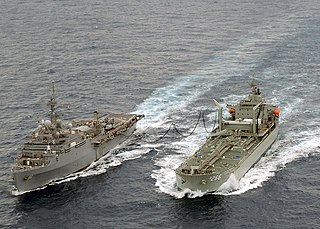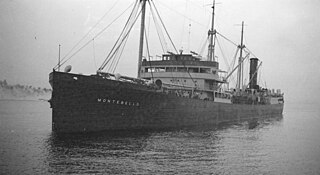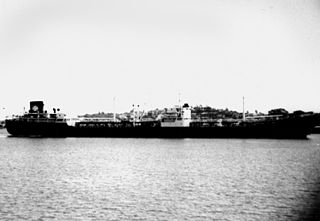Related Research Articles

A replenishment oiler or replenishment tanker is a naval auxiliary ship with fuel tanks and dry cargo holds which can supply both fuel and dry stores during underway replenishment (UNREP) at sea. Many countries have used replenishment oilers.

Hammac was a steam tank ship built in 1920–1921 by Bethlehem Shipbuilding Corporation of Alameda for the United States Shipping Board as part of the wartime shipbuilding program of the Emergency Fleet Corporation (EFC) to restore the nation's Merchant Marine. Early in 1923 the vessel together with two other tankers was sold to General Petroleum Corporation and renamed Emidio. The tanker spent the vast majority of her career carrying oil along the West Coast of the United States as well as between West and East coast. In December 1941 she was shelled and damaged by the Japanese submarine I-17 and eventually wrecked with a loss of five crewmen.

SS Potrero del Llano was an oil tanker built in 1912. She sailed for a number of companies, and survived service in the First World War, only to be torpedoed and sunk by a German U-boat during the Second World War while sailing under the Mexican flag off the coast of Florida. Her sinking contributed to Mexico's decision to enter the war on the side of the Allies.

The Battle of the Caribbean refers to a naval campaign waged during World War II that was part of the Battle of the Atlantic, from 1941 to 1945. German U-boats and Italian submarines attempted to disrupt the Allied supply of oil and other material. They sank shipping in the Caribbean Sea and the Gulf of Mexico and attacked coastal targets in the Antilles. Improved Allied anti-submarine warfare eventually drove the Axis submarines out of the Caribbean region.
Silvanus was a steam tanker built in 1920–1921 by the Southwestern Shipbuilding & Drydock Company of San Pedro for the Anglo-Saxon Petroleum Company with the intention of transporting oil and petroleum products between Dutch East Indies and various destinations in Europe and the Far East. The tanker was employed in this capacity through the first part of 1926. In April 1926 Silvanus collided with the tanker Thomas H. Wheeler in the Mississippi River, resulting in the explosion and death of 26 seamen. Silvanus was declared a total loss and sold at auction to the newly formed Petroleum Navigation Company of Texas. The tanker was rebuilt and renamed Papoose and started operating in March 1927. In March 1942, she was attacked by German U-boat U-124 off the coast of North Carolina. The ship drifted for several days and eventually sank in 200 feet (61 m) of water off Oregon Inlet.

Montebello was a steam oil tanker built in 1920–1921 by the Southwestern Shipbuilding Co. of San Pedro for Union Oil Company. It was designed to carry oil and petroleum products along the West Coast of the United States and Canada, as well as between the United States and Chile. In December 1941 the tanker was sunk on one of her regular trips by the Japanese submarine I-21.
Sylvan Arrow was a steam tanker built in 1917–1918 by New York Shipbuilding Co. of Camden for Standard Oil Company, with intention of transporting oil and petroleum products between United States and ports in the Far East. The ship was briefly requisitioned by the US Government during World War I but returned to commercial service in early 1919.

The German ship Doggerbank was a UK cargo ship that was built in Scotland in 1926, captured by the German Navy in 1941, renamed Doggerbank and converted into an auxiliary minelayer and blockade runner. The German U-Boot U-43 (1939) sank her by mistake in 1943, leading to the deaths of all but one of her 257 passengers and 108 crew.
Katina P was a Greek oil tanker carrying 72,000 tonnes of oil which sank off the Mozambique coast on 26 April 1992.

HMCS Fredericton was a Flower-class corvette of the Royal Canadian Navy. She was ordered from Marine Industries Ltd. in Sorel, Quebec and laid down on 22 March 1941. She was launched on 2 September 1941 and commissioned on 8 December 1941. She was named after the community of Fredericton, New Brunswick.
MV C.O. Stillman was an oil tanker that was built by a German shipyard in 1928 for a Canadian-based shipping company. A Panamanian subsidiary of Esso bought her at the end of 1936 and she was sunk by the German submarine U-68 in the Caribbean on June 4, 1942 about 41 nautical miles (76 km) southwest of Isla de Mona, Puerto Rico.
SS Las Choapas was an oil tanker built in 1898. She was originally commissioned by Standard Oil of New Jersey and built by the Delaware River Iron Ship Building and Engine Works of Chester, Pennsylvania. As the SS Atlas she saw service in World War I before being sold in the 1920s to the Italian company Ditta G.M. Barbagelata, of Genoa.
RFA Darkdale was a Dale-class fleet tanker of the Royal Fleet Auxiliary (RFA), launched on 23 July 1940 as Empire Oil, completed in November 1940 and transferred to the RFA as Darkdale. She was sunk during the Second World War on 22 October 1941 by the German submarine U-68. Her wreck in James Bay off Jamestown, Saint Helena continued to leak oil, posing a potential environmental threat to the coastal waters of Saint Helena, until Ministry of Defence divers drained the ship's tanks in 2015.

MV Imperial Transport was an oil tanker built in the early 1930s for the Houlder Line. During World War II, the ship was torpedoed by a German submarine in early 1940 and broke in half. The stern section was saved and a new forward half was built and mated to the ship, which returned to service in 1941. Imperial Transport was torpedoed again in early 1942, but her crew was able to get her back to port. She was repaired in the United States and was back in service by early 1943. The ship was sold to a Norwegian company in 1947, sold again two years later and finally scrapped, in 1958.
R. W. Gallagher was a steam turbine-powered tanker built in 1938 by Bethlehem Shipbuilding Corporation of Quincy for Standard Oil Company of New Jersey with intention of operating between the oil-producing ports of the southern United States and Mexico and the Northeast. The tanker spent her entire career in coastwise trade and was torpedoed and sunk on one of regular journeys in July 1942 by German submarine U-67.

Tonan Maru No. 3, from 1951 simply the Tonan Maru, was a Japanese whale oil factory ship. Built at Osaka in 1938 she was the largest merchant ship built in Japan to that point. She carried out whaling in the South Atlantic and in 1941 was blacklisted by the British government, believed to be because she was suspected of refuelling German vessels in the Pacific during the Second World War. Following the Japanese entry into the war Tonan Maru No. 3 was operated as an oil tanker in support of military operations. She survived 11 torpedo hits from USS Tinosa in 1943 as most failed to detonate. Tonan Maru No. 3 was sunk in Chuuk Lagoon by carrier-based aircraft in the 17 February 1944 Operation Hailstone. She was salvaged by Japan after the war, rebuilt and returned to service as the Tonan Maru in 1951. She returned to whaling and was scrapped in 1971.
References
- ↑ Mckee, Darlington, Fraser, Robert (1996). The Canadian Naval Chronicle. Canada: Vanwell Publishing. pp. 228–229. ISBN 1-55125-032-2.
{{cite book}}: CS1 maint: multiple names: authors list (link) - ↑ "Canadolite - (1926-1941)". www.aukevisser.nl. Retrieved 2015-12-18.